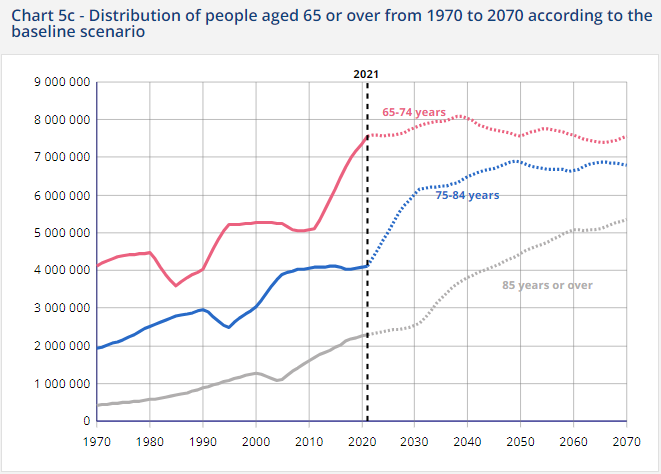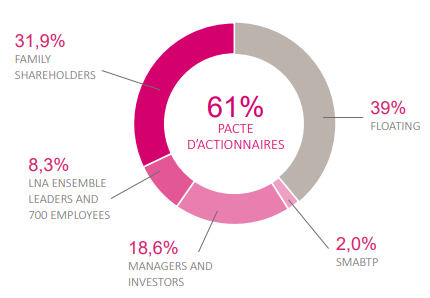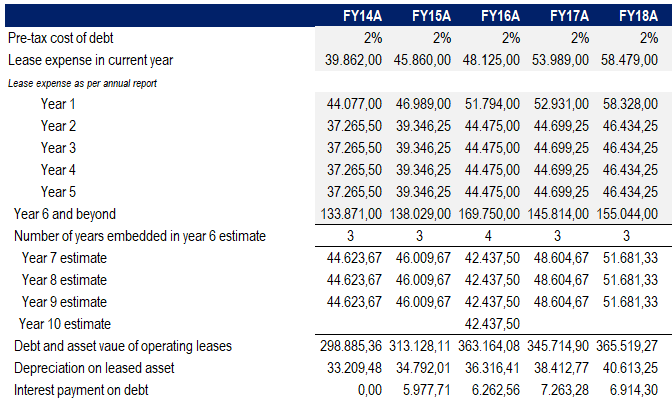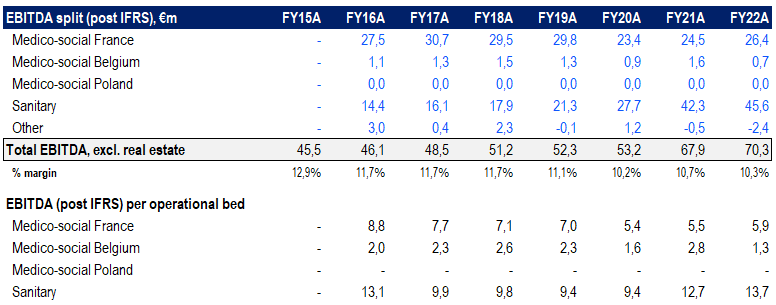LNA Santé (EPA:LNA)
An "innocently convicted" care home operator poised for a promising future
Note: Most investor material is provided in French. I know a maximum of three words in French (bonjour, merci, croissant), and thus I might have missed something crucial - Google translate only goes so far. Remember; I am just a stranger on the internet, so none of the information provided should be regarded as investment advice.
Twitter: Thepiccledotcom
Introduction
LNA Santé (EPA:LNA), a French care home operator, has seen its stock cratered on the back of the launch of investigative journalist Victor Castanet’s book, “The Gravediggers.” Taking its standpoint in the largest French care home group, ORPEA Group (EPA:ORP), the exposé highlights the heartless mistreatment of elderly residents. Quotas on the number of diapers to be used per day - and actively trying to bring this number down from 3 to 2.7, and then <2.2 times per day, is among one of the many examples mentioned in his book. The launch of this book caused a massive public debate, which ultimately resulted in the French government announcing its plans to increase its oversight. As for ORPEA Group, I don’t think it can be summarized better than by looking at this chart:
In the midst of the ORPEA-ordeal, French media broke a story showing similar operational (mal)practices inside another large care home operator, Korian - now called Clariane (EPA:CLARI) - whose stock has also been demolished. It also doesn’t help that both of these names have levered their balance sheets significantly leading up to this scandal, magnifying their crisis as the interest rates have soared.
While the above development is justified, it would be a shame to say that this is standard practice among all care home operators. However, looking across the pool of publicly traded care home operators in France, the market seems to think that is the case - presenting a highly attractive opportunity for patient investors. Here is how shares of LNA Santé have traded, despite being cited positively in Victor Castanet’s book:
LNA Santé at a glance
Operating care homes in France, LNA Santé is a majority family-owned business. The company was founded by Jean-Paul Sire who led the company from its founding in 1992 up until 2021 when the keys were handed to his son, and current CEO, Willy Siret who has been part of operations since 1999.
The company is the third largest care home operator with 9,390 beds, 82 facilities, and ~8,900 FTEs, only surpassed by ORPEA Group, and Korian/Clariane. Operations are divided into three segments: 1) Medico-social, 2) Sanitary, 3) Other.
The Medico-social (44% of FY22A revenue)
The Medico-social segment operates a total of 45 retirement homes (EHPAD) in France, and 4 in Belgium, offering a combined 5,335 beds of which 5,053 are fully operational with the remainder still under development. Accommodation is provided on a full-time, temporary, or sequential basis depending on the circumstances of the resident, and are usually financed by a mix of health insurance (35% rate), family/one self, and third-party associations.
Occupancy rates across both France and Belgium sits comfortably at ~94% and ~90%, respectively. This is to be compared with ~80-85% for both of the troubled peers (ORPEA Group and Korian/Clariane) - a testament of LNA Santé’s superior operating efficiency.
The Sanitary (56% of FY22A revenue)
The Sanitary segment includes 20 medical & rehabilitation clinics (SMR), 2 psychiatric clinics (PSY), 2 surgery clinics (CHIR), and 9 hospitals at home/home care (HAH) across France, Belgium, and Poland.
The 20 SMR facilities provide patients with comprehensive rehabilitation and reintegration services. The primary objective of the rehabilitation services is to facilitate the patient's physical, mental, or physiological recovery, equipping them with the necessary tools to manage their daily challenges. Meanwhile, the reintegration services are designed to assist patients in successfully transitioning back into society once they are deemed able to do so. Given the nature of the offering, most accommodations are on a full-time basis (~90%) with an average stay of ~37 days.
The 2 psychiatric clinics provide specialized care and treatment for individuals who are experiencing various mental health challenges or disorders. The units are designed to offer a controlled and therapeutic environment where patients can receive comprehensive assessment, diagnosis, and treatment for their mental health conditions. Similarly, most stays (~70%) require full hospitalization, with an average stay of ~2 months - biased upward by a smaller group (~5%) who are hospitalized for >6-12 months.
The 2 surgery clinics conduct specialized and less extensive surgery services (i.e., dental), and typically (~63%) do not require patients to stay at the facilities overnight.
Hospital at home/home care, provides patients with medical and paramedical services directly in the comfort of their own homes. The nature of care offered in this segment distinguish it from standard home-based care as it aims to mitigate or minimize the necessity for complete hospital admission.
LNA Santé is also engaged in real estate development, albeit on a more peripheral basis compared to ORPEA Group and Korian/Clariane. Unlike the two competitors who possess their real estate holdings, LNA Santé only holds real estate assets during their developmental stages. Subsequently, all completed facilities are sold to real estate investors, and the company maintains its role solely as the operator. Real estate exposure of some magnitude is a prerequisite given local laws for care home operator - more on this in the upcoming section.
Note: As of FY22A, the company reports using four segments: 1) Medico-social France, 2) Sanitary France, 3) International, and 4) Other. The International segment contains its operations in Poland and Belgium.
Another distinguishing - and important point - is the company’s ownership structure. With the founding family as majority shareholders coupled with a large chunk of inside ownership, the interests are very much aligned with that of shareholders.
Market
LNA Santé operates in an incredibly fragmented industry with no clear market-leader, making the industry an interesting case of potential consolidation. Indeed, both ORPEA Group and Korian/Clariane, backed by private equity, seem to have been driven by this precise investment rationale - industry consolidation. With the recent scandal, an industry shake-up may provide interesting M&A opportunities for players with strong balance sheets, such as LNA Santé.
Care home operators are required to secure regulatory approval in the form of licenses to operate their facilities. Acquiring these licenses involves a complex and intricate procedure, and the French government has demonstrated a cautious approach in granting such permissions (quite literally frozen). New authorizations are predominantly linked to the conversion of existing facilities within connected industries. These characteristics further fuel M&A activity in the space as private operators seek to acquire said licenses from smaller players (or state-run facilities) to grow their fleet/beds. Put differently, the barriers to entry are significant. This is also explains the real estate exposure of LNA Santé as they acquire said facilities (real estate + license), remodel the buildings, sell the real estate, and then include the new facility as part of their current offerings.
It is no secret that the average age is increasing, especially in the western world. Not only are we getting older - we are also older for longer. Put bluntly; there is a growing need for care homes. Here is a look of the age development in France.

According to data from INSEE, this trend is expected to continue at a similar rate until 2040:

At current pace, the supply of beds in France is simply not adequate - and with the limited grants of new licenses, pressure is bound to increase. This topic is routinely part of public debates in France, and I think it is sensible to expect the government to collaborate closer with private operators, i.e. by selling more state-run facilities to private operators who have demonstrated an ability to run care homes efficiently while still conducting periodic controls to circumvent ORPEA-like scandals going forward. Without having done the math on it, I don’t think the government would be able to lift this weight all by themselves - in fact, I don’t think it is in their interest considering its already accelerating health-care spending. It would not be the first time France have done so. This may seem in contrast to the country’s history of “laissez-faire” policy-making - prioritizing minimal government intervention in economic and social affairs. However, even during these periods, selective intervention was not unheard of. France was instrumental in the creation of the Common Agricultural Policy (CAP) of the European Union, providing subsidies and support to farmers to ensure food security, stabilize prices, and preserve rural communities. All this is to say; a public-private relationship as put forth above is not unthinkable.
Financial development
As mentioned at the outset of this write-up, the ORPEA scandal has significantly impacted the valuation of French care home operators collectively, although some have been hit harder than others. LNA Santé is one of the “lucky” players with a less violent drop - likely due to the ownership structure, and the fact that the company actually appears to be operated well.
Looking at the operating EV/EBITDA multiple, it is clear to see how valuation has fallen back to its circa 2015-level. The only thing that may justify this fall is if EBITDA for will retract meaningfully. From its recently published H2 numbers, that does not seem to be the case as the CEO communicated his confidence in the guidance for FY23

It was not until FY19 that the company adopted IFRS 16 reporting, hence each year prior to this point has been adjusted to keep consistency. Here is an overview for those curios:
As noted earlier, real estate activities are not part of core operations, hence financials should be adjusted to reflect this.
Unit-economics
The “installed base” in this case is the number of beds that LNA Santé have installed across its 82 facilities. The company distinguishes between beds in operation (“cruising mode”) and beds not currently in operation (“restructuring”) - the former refers to beds that are, for instance, located in buildings undergoing renovation and thus cannot accept patients yet. Here is an overview:
Naturally, during leaps of larger expansion, the % of beds in “cruise mode” will be lower for the first year or two until the facility is ready to operate at full capacity. Layering the above with segmented sales allows for insight into price/volume levers the company may utilize for growth:
While both volume and pricing has been a contributor - volume seems to be the primary contributor in the beginning years (FY15-20) from which point, pricing has been playing a larger role. Adding a layer of complexity, the growth is also a function of the occupancy-rate (% of operational beds utilized). I was unable to locate the occupancy rates prior to FY19, but here is an overview of the segmented occupancy rate:
Although additional data would have been preferred, the impact - and subsequent recovery - from Covid is clear. That said, from a profitability standpoint, margins have yet to recover to its pre-covid levels. Part of this is driven by the rise in labor costs and energy prices.
While energy prices can (and have been) hedged, the labor situation - much like that of many European nations, seems to be more structural due to the scarcity of available workforce within this sector. While aspects of this can only be mitigated from the government promoting such career-path, private care home providers must also do their part to attract talent.
Medico-social France and Medico-social Belgium have seen lower margins, whereas Sanitary has seen the opposite trend. The company has also leaned more toward this higher-margin segment in recent years:
Admittedly, some of the margin-uptick is attributable to post-covid effects as many surgeries were cancelled during covid. This backlog has benefitted LNA Santé as we have returned to normalcy - evidenced by the >97% occupation rate in FY22A. This will likely be the case for at another year or two. In terms of margin recovery for the Medico-social France, pricing and/or stabilizing costs may be the only levers available. However, Medico-social Belgium do have a third lever; improving its occupancy rate to match that of Medico-social France.
The ORPEA-scandal may pose as a challenge, particularly to the Medico-social France segment. It would not come as a surprise if the occupancy rates suffer in the short term - but it should recover rather promptly as the public learns that LNA Santé is in fact (so far so good) an honest company, taking proper care of its patients/residents. Thus, the counter argument also seems logical; families with loved ones living at ORPEA or Korian/Clariane may want to relocate to LNA Santé’s facilities. With its recent expansion into Poland, the company does not see its number of installed beds stagnating anytime soon.
For comfort, most of its targets communicated since FY15 have either been met or surpassed years in advance. This is the case both for abovementioned KPIs as well as its annual financial guidance (aside from FY20).
A simple, predictable, free-cash flow generative business with high barriers to entry, limited cyclicality and investment needs, a strong balance sheet, minimal capital market dependency, great management, and trading at an attractive valuation
Borrowed from Ackman, the above summarizes many of the characteristics present in LNA Santé. Having noted that, the company did secure approximately €50 million through a fresh share issuance at a trading price of €52.50 per share. Notably, the majority of the raised capital was underwritten by the founding family and insiders.
As illustrated below, operations are without a doubt cash generative. Underpinning the cheapness of the stock at current levels, the company has never generated FCF yields similar to current levels. Again, I have tried to strip-out the impact of non-operating elements from real estate.
Looking at ROIC (again, adjusted for real estate), the growth has been value accretive. However, since covid, ROIC has been downward sloping driven by the aforementioned lower margins. It should recover once margins return to pre-covid levels.
On the surface, the balance sheet appears to be very levered. However, as noted earlier, much of the leverage relates to the real estate assets which are not held long-term. While it's important to distinguish between the two, it's the cash flow generated from the core operations that covers the interest expenses linked to real estate-related loans. For this reason, the covenants on the real estate loans have been established to encompass the entirety of the business. As of FY22A, the operating leverage (pre-IFRS) is 1.87x, leaving considerable headroom to its 4.25x ceiling. This positioning provides a buffer to accommodate fluctuations (i.e., from increasing interest rates (hedged) and/or lower real estate prices). The potential losses incurred from selling real estate assets at a price lower than their acquisition cost could pose a significant challenge for LNA Santé. This risk has the potential to leave the company with a debt burden which will slow its growth as additional real estate debt (€340m limit) would result in a breach on covenants.

Valuation
It should be clear by now that I think LNA Santé deserves a higher valuation. My forecasts say the same thing, even though I am quite conservative. Here is the revenue model:
I assume that the actual operational bed count will fall below the guided figures, but expect that revenue per operating bed will rebound as price adjustments are implemented. The above approach, while straightforward, is merely a single method of constructing the revenue model. Nonetheless, when considering historical trends, the growth rates appear to be rather cautious. As for the margins, I anticipate a slow recovery back to its historical levels of ~11.5%, expanding 20bps per year from 10.5% in FY23E.
Effective tax rate at 35%, a gradual reduction in the delta NWC ratio from -1.75% of sales in FY23E to -1% of sales in FY28E, consistent CapEx at -2% of sales across all years, an exit multiple of 10x, and a WACC of 8.5%, I arrive at an estimated value of approximately €44/hare. This presents a potential upside of ~45%. In a more optimistic scenario, my calculations indicate a value of around €70/share.
It's important to note that I do not account for potential advantages stemming from favorable M&A opportunities resulting from ORPEA Group's current challenges or government support directed towards private care home providers. These factors could further influence the valuation and potential returns.





















Dear Piccle, Dear friends of LNA Sante,
yesterday the numbers for 2023 came out and the outlook for 2024.
There is volume growth. The problem is not the debt (return on invested capital of 8% versus interest of 4%). 150 million are available for external acquisitions.
The concern that will impact the company's valuation is its net margin, which will be affected by government-regulated prices that do not follow inflation. Is it temporary? or permanent? Should the 4% net margin target be revised?
At the moment I don't think so, but it would be worth asking the question of how we can solve the problem of a state that no longer has the budget to finance healthcare.
What opinion do you have @Piccle/do you have @Community about the new findings?
Kind regards and happy easter
Thank you for this idea. What do you think about 1H results and the insufficient contribution from the State?